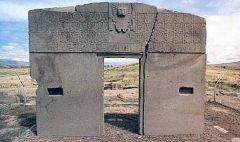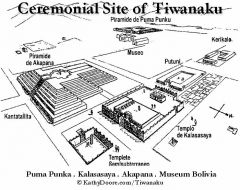![]()
![]()
![]()
Use LEFT and RIGHT arrow keys to navigate between flashcards;
Use UP and DOWN arrow keys to flip the card;
H to show hint;
A reads text to speech;
4 Cards in this Set
- Front
- Back

|
Reconstruction of the Akapana mound (pg. 136) Middle Horizon, 200 BCE - 1,000 CE (Tiwanaku State: 200 CE - 1,000 CE) Stone-faced tiers, sunken courtyard on top level Puma tenon heads dotted the surface and a burial of a high priest held a puma effigy incense burner --> A monument to shamanic transformation into Puma / strong puma iconography Evidence of a palace - visual hierarchy Water = important element: Channeled water through intricate pipe system, water ran down sides of structure, imported bluish-green gravel to place in upper terraces to invoke color of water in dry periods Structure points towards East "man-made" mountain Moat: rep. Lake Titicaca --> becomes like an island Many decapitated skeletons found on site - human and animal sacrifice --> suggests seriousness of the space |
|

|
Semi-sunken plaza/temple (pg. 138) Early Intermediate Period - Middle Horizon Numerous monoliths interspersed with smaller stones, grand portals, and tall sculptures Tenon heads - rudimentary/scematic faces - Rep. different clans/areas/ethnicities - acknowledging cultural differences, but also bringing them together in this one place - Natural stonework implemented/integrated in with perfectly crafted stones (various types of stone throughout) Space is designed to force you to MOVE about; theatrical |
|

|
The Sun Gate (pg. 140-141) Early Intermediate Period - Middle Horizon the city's foremost decorated portal showing the portal god/puma shaman surrounded by winged attendant figures with bird and human heads --> this imagery was spread throughout Tiwanaku and Wari empires (primarily textiles) THRESHOLD: - a powerful space that can be granted or denied access to and can also rep. change or transformation - likely a later addition to the city - found on its side --> not sure where it originally stood - stonework from Tiwanaku was recycled after its downfall - monolithic, made out of 1 giant piece of stone MOVEMENT IN ARCHITECTURE: - indented doorway (double-jambed door / a door within a door --> duality) creates a tunnel-like entrance --> moving space forward - top element projects outward slightly --> moving space backward / high and low relief TOP OF PORTAL: - frontal, rayed being on the dais (may rep. the Akapana) hold a spear-thrower in his right hand and arrows in his left - winged attendants are human or bird-headed and also carry arrows as staffs Imagery on gate = high appropriate, whether for ritual purposes to shepherd performers from one sacred place to another or, on a higher symbolic level, to embody the change of consciousness as a passage through a cosmic portal. |
|

|
Reconstruction of City Center (pg. 134) Early Intermediate Period - Middle Horizon |

